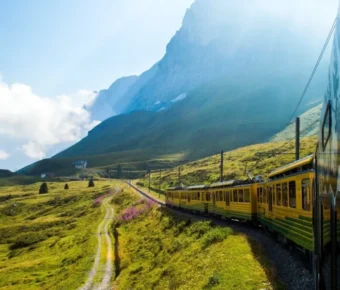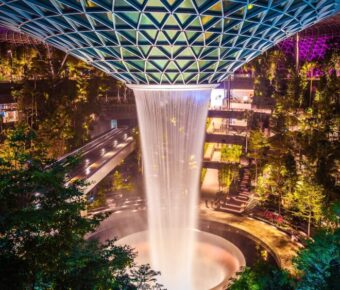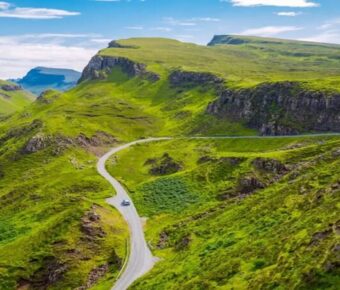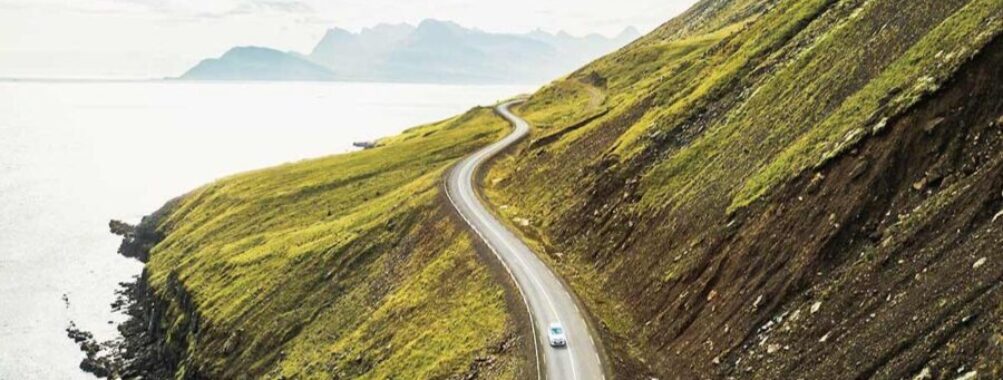
Driving Iceland Ring Road Itinerary 10 Days: Expert Tips, Hidden Gems, and Must-See Stops for the Ultimate Adventure
Thinking about cruising past wild landscapes, ancient volcanoes, and roaring waterfalls in Iceland? Driving the Ring Road in 10 days gives you time to soak in the adventure—without rushing past the real magic. You’ll stumble on tiny villages, scenery that makes you pull over just to gawk, and more than a few “how is this real?” moments.
Ten days is enough to loop the island, hit Reykjavik, the Golden Circle, the East Fjords, and still have room for a few curveballs. I’ve circled Iceland more times than I should admit—bring a raincoat, extra snacks, and a sense of humor. You’ll need all three.
Table of Contents
- Key Takeaways
- Essential Trip Planning for 10 Days on Iceland’s Ring Road
- Best Time to Drive the Ring Road
- Route 1 Overview and Driving Distances
- Budgeting and Cost-Saving Tips
- Campervan vs. Car Hire
- Packing and Gear Recommendations for All Seasons
- Weather-Appropriate Clothing
- Hiking and Outdoor Equipment
- Travel Essentials for Self-Drive
- 10-Day Iceland Ring Road Itinerary Schedule
- Route Map and Daily Breakdown
- Must-See Sights and Hidden Gems
- Day 1: Reykjavík and Reykjanes Peninsula Highlights
- Blue Lagoon and Geothermal Wonders
- Culture and Landmarks in Reykjavík
- Day 2 & 3: The Golden Circle and South Coast Adventures
- Thingvellir National Park and Geysir Area
- Gullfoss and Secret Lagoon Stops
- Selfoss and Seljalandsfoss Waterfalls
- Day 4: Black Sand Beaches and Vík Region
- Reynisfjara Black Sand Beach
- Dyrhólaey and Coastal Views
- Sólheimasandur and Skógafoss
- Day 5 & 6: Vatnajökull Glacier and Southeast Iceland
- Skaftafell and Glacier Hiking Routes
- Svartifoss and Fjaðrárgljúfur Canyon
- Jökulsárlón and Höfn
- Day 7 & 8: East Fjords and Scenic Villages
- Seyðisfjörður and Egilsstaðir
- Wildlife Watching in East Iceland
- Day 9: Mystical North Iceland and Akureyri
- Dettifoss and Waterfall Wonders
- Mývatn and Geothermal Pools
- Whale Watching and Akureyri Sights
- Day 10: West Iceland and Snæfellsnes Peninsula
- Kirkjufell and Kirkjufellsfoss
- Stykkishólmur and Djúpalónssandur
- Adventure Activities Along the Ring Road
- Glacier Tours and Ice Cave Expeditions
- Top Hiking Trails
- Practical Travel Information and Insider Tips
- Staying Safe While Driving
- Northern Lights Spotting Guide
- Unique Hot Springs Off the Beaten Path
- Frequently Asked Questions
- What are the must-see attractions along the Iceland Ring Road in a 10-day itinerary?
- How should I budget my time between North and South Iceland during a 10-day Ring Road trip?
- What are some hidden gems or off-the-beaten-path stops along the Ring Road to include in a 10-day journey?
- What are the driving conditions like along the Ring Road in Iceland during different seasons?
- Can you recommend accommodations or camping options for a 10-day self-drive tour of the Ring Road?
- What are essential tips for driving safely on Iceland’s Ring Road over a 10-day period?
- Book Your Dream Experience
- More Travel Guides
Key Takeaways
- 10 days is the sweet spot for exploring Iceland’s Ring Road.
- Pack smart and prep for all kinds of weather.
- This guide covers highlights, clever tips, and stops you won’t want to miss.
Essential Trip Planning for 10 Days on Iceland’s Ring Road
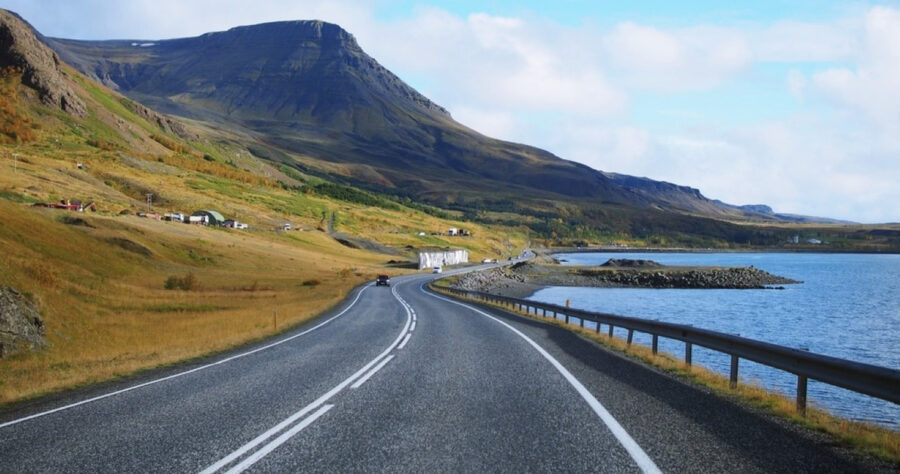
A full loop around Route 1 throws dramatic landscapes, wild weather, and a surprising amount of logistics your way. If you get your timing, budgeting, and wheels sorted, you’re already halfway to an epic trip.
Best Time to Drive the Ring Road
Most folks show up in summer, June to August. There’s endless daylight—seriously, 20+ hours—and just about everything’s open. Waterfalls are roaring, fields are green, but crowds and prices spike. If you’re not into crowds, May or September usually sneak you in before the rush with decent weather and open roads.
Winter (October-April) is a different beast. Expect snow, strong winds, and road closures—especially on side routes. Some parts of Route 1 turn icy, but you might catch the northern lights if luck’s on your side. It’s not for everyone. Be honest about your winter driving skills. Always check weather and road status before heading out, no matter the month.
Route 1 Overview and Driving Distances
Iceland’s Ring Road—Route 1—loops about 1,332 km (828 miles) around the island. Most of your drive runs from Reykjavik, down the south coast, through the east fjords, up north past Akureyri, and back to Reykjavik. You’ll probably drive 2-4 hours daily, but that doesn’t count all the stops for waterfalls, sheep, or sudden rainbows.
Speed limits hit 90 km/h (56 mph) max on paved roads, but you never want to rush. Gravel patches, surprise storms, or a herd of Icelandic horses can pop up out of nowhere. Plan your main stops, but leave some space for surprise detours (trust me, Iceland’s all about those). Oh, and download an offline map—you’ll thank yourself later.
Budgeting and Cost-Saving Tips

Iceland is expensive. Food, fuel, even campsites, everything adds up over 10 days. Hit grocery stores like Bónus or Kronan for basics—bread, skyr, cheese, snacks. You’ll save a ton compared to eating out.
Fuel will eat a chunk of your budget. Most gas stations are self-serve and 24/7 (at least for card payments). Campsites usually cost way less than hotels or guesthouses, but prices jump around by region. If you want to dodge bedding fees, bring your own sleeping bag. Booking your car or camper early at vuelos, hoteles y autos de alquiler usually scores you better rates.
If you crave a fancy meal or guided tour, maybe just pick one or two splurges. Most natural highlights—waterfalls, hikes—cost nothing. Coffee refills can get silly expensive, so bring a thermos!
Campervan vs. Car Hire
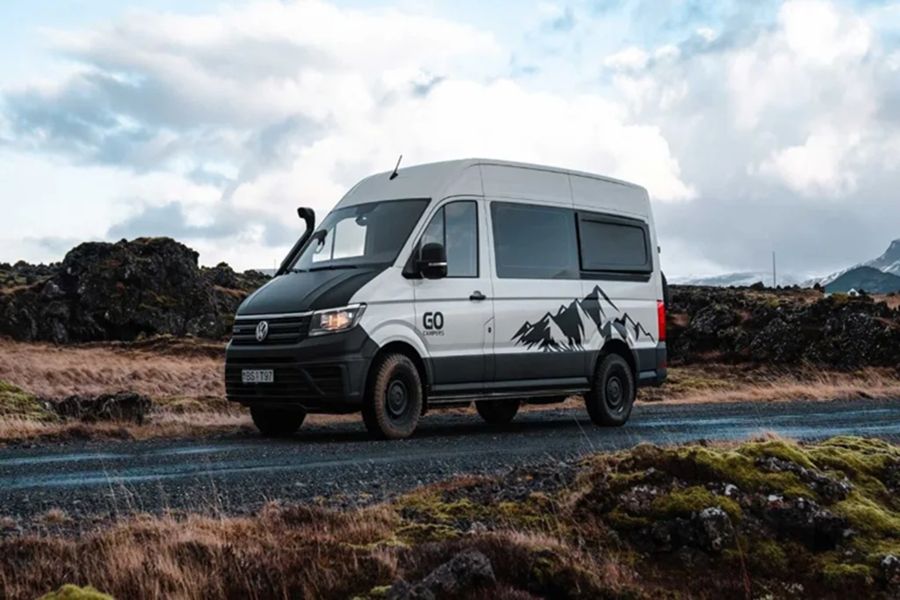
People always ask: car and hotels, or campervan? Both work, but your style and budget will nudge you one way or the other.
A campervan gives you wild flexibility. You can camp out wherever there’s a site (and there are loads), plus you wake up to some pretty wild views. You’ll save a good chunk on hotels, and cooking your own meals helps. But campers can feel cramped, and showers aren’t always a sure thing. Icelandic nights get chilly, even in July—bring a real sleeping bag.
With a rental car, you’ll probably get a comfier bed and a hot shower every night. Hotels and guesthouses fill up fast and aren’t cheap, though. Want to compare cars? Try auto de alquiler, but always look at mileage and insurance. I’ve done both—and honestly, I loved the freedom of a camper, but my back prefers a real mattress.
Quick heads-up: Icelandic law says you have to sleep at official campsites, not just pull over anywhere. Campsite quality is a mixed bag—sometimes you luck out with a hot tub, sometimes not. Roll with it.
Packing and Gear Recommendations for All Seasons
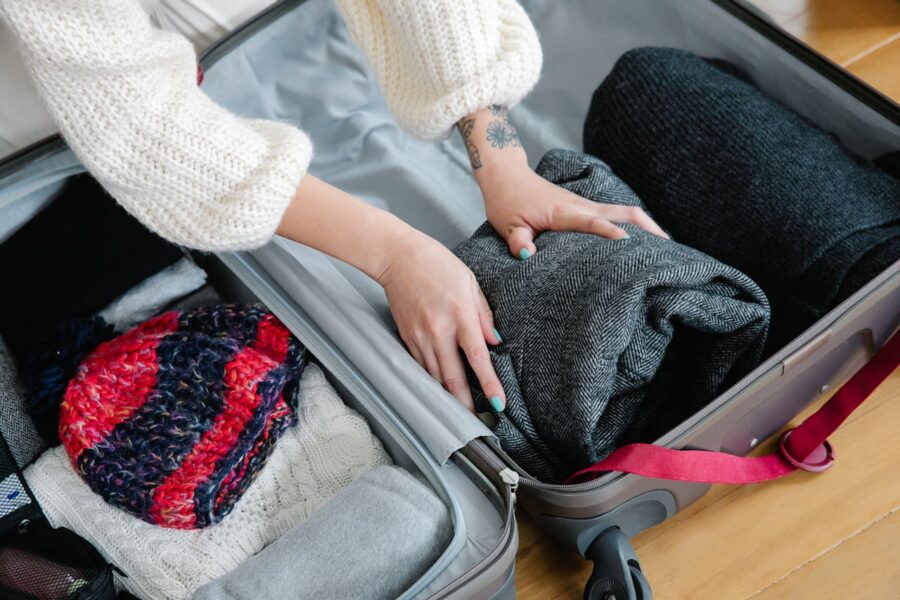
Packing for the Ring Road isn’t just tossing your favorite hoodie in a bag. Think layers, sturdy gear, and a few clever travel items. The right stuff will save you from misery when you’re hopping out at black sand beaches or hiking up to a glacier.
Weather-Appropriate Clothing
Iceland’s weather? Unpredictable at best. Rain, wind, and cold can all show up in a single afternoon. Layers are your best friend. Bring breathable base layers (wool or synthetic beats cotton), a warm mid-layer like fleece, and a solid waterproof jacket.
You’ll want a hat, gloves, and a scarf. Seriously, waterproof pants are not a joke here. I’ve been blasted by sideways rain in July. Bring extra socks (wool, always). No matter the season, expect wind and drizzle.
Hiking and Outdoor Equipment
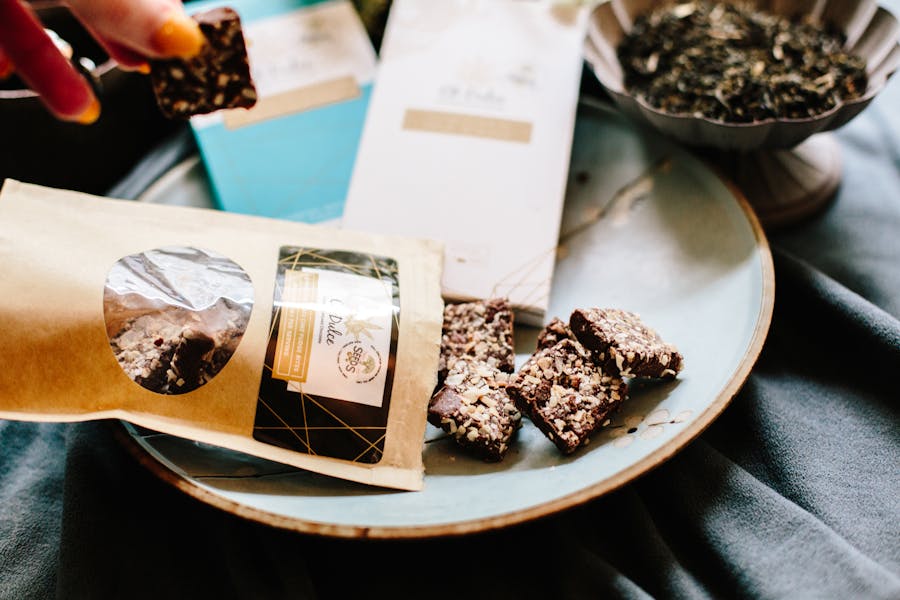
The roads get you close, but the hikes are where Iceland really comes alive. Bring hiking boots—sneakers just don’t cut it. If you’re coming in winter or plan to hike icy trails, lightweight crampons are a game changer.
A daypack for snacks, water, and layers is handy. Trekking poles help on rocky or uneven ground (my knees thank me every time). Sunglasses and sunscreen might sound weird, but the sun bounces off snow and ice—even on cloudy days.
Travel Essentials for Self-Drive
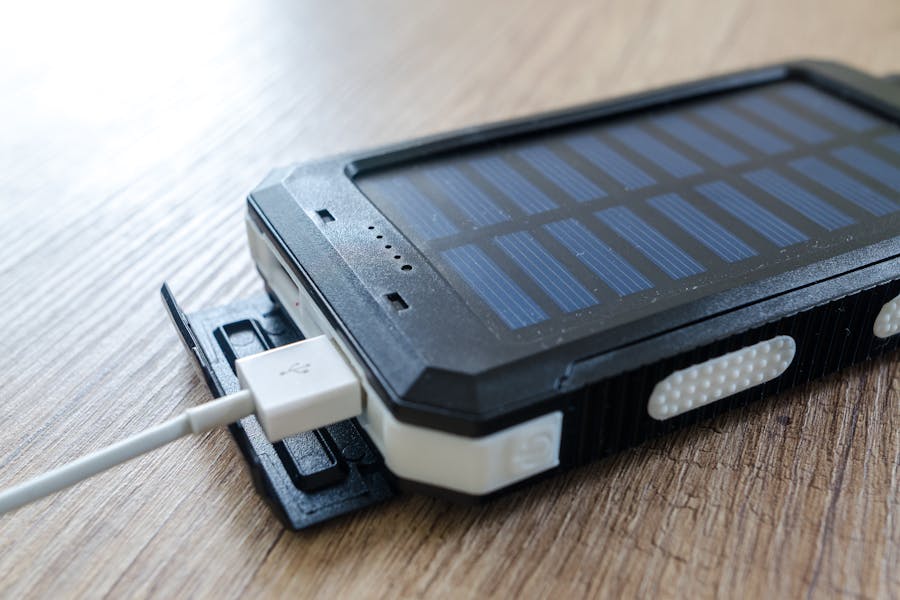
Driving the Ring Road is an adventure in itself. Pack a car charger for your phone and a solid GPS or offline map—cell service drops out in the middle of nowhere. Keep paper copies of bookings just in case. A small cooler for snacks and drinks saves time and money.
Bring a flashlight or headlamp, especially if you’re here in winter. A basic first aid kit is smart—bandages, painkillers, and a blister patch can save your day. If you’re missing anything, check out some travel gear for last-minute essentials. Don’t forget a reusable water bottle and a thermos—trust me, you’ll use them.
10-Day Iceland Ring Road Itinerary Schedule
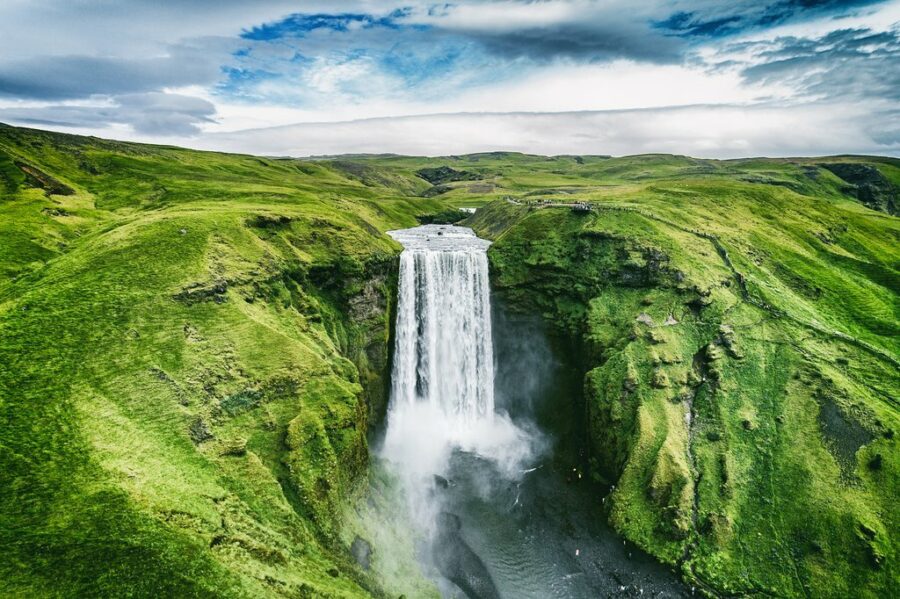
With 10 days on the Ring Road, you’ll see way more than waterfalls and glaciers. The real fun is in the drives, the quirky stops, and those “should we pull over?” moments that become the best stories.
Route Map and Daily Breakdown
Route 1 loops around the whole island—about 1,330 km—and hits Iceland’s best and weirdest. Most people start in Reykjavik and go counterclockwise.
Here’s how a classic 10-day trip usually breaks down:
| Day | Start/End | Main Stops |
|---|---|---|
| 1 | Reykjavik → Vik | Seljalandsfoss, Skógafoss, Reynisfjara |
| 2 | Vik → Höfn | Fjaðrárgljúfur, Jökulsárlón, Diamond Beach |
| 3 | Höfn → Egilsstaðir | East Fjords, Djúpivogur, Petra’s Stone Collection |
| 4 | Egilsstaðir → Lake Mývatn | Dettifoss, Húsavík detour |
| 5 | Lake Mývatn → Akureyri | Grjótagjá Cave, Goðafoss |
| 6 | Akureyri → Hvammstangi | Siglufjörður, Herring Era Museum |
| 7 | Hvammstangi → Snaefellsnes | Vatnsnes seals, Borgarvirki |
| 8 | Snaefellsnes Peninsula | Kirkjufell, Snæfellsjökull Park |
| 9 | Snaefellsnes → Reykjavik | Deildartunguhver, Hraunfossar |
| 10 | Reykjavik & Blue Lagoon | Explore city or soak at Blue Lagoon |
You’ll drive 2-4 hours most days, but factor in time for sheep traffic, food trucks, or chasing your hat down the road.
Must-See Sights and Hidden Gems

Jökulsárlón Glacier Lagoon gets all the Instagram love, but Fjaðrárgljúfur canyon (say it “fiath-raur-glyoo-vur”—kind of) might just steal your heart. Don’t zoom past the East Fjords—there’s wild geology and puffin colonies everywhere.
Check these out:
- Seljalandsfoss: You can walk behind it. You’ll get wet.
- Húsavík: Detour for whale watching. Seriously, don’t skip it.
- Goðafoss: Best before the crowds show up late morning.
- Grjótagjá Cave: A tiny, steamy lava cave—Game of Thrones fans will recognize it.
- Siglufjörður: Feels like a secret fishing town at the edge of the world, and the herring museum is way more interesting than you’d expect.
Hidden gem alert: Borgarvirki. It’s a natural fortress—windy, wild, and the views are unreal.
Watch for gravel roads leading to fjord viewpoints or tiny turf houses. Sometimes, those unplanned detours are the moments that stick with you long after you’re home.
Day 1: Reykjavík and Reykjanes Peninsula Highlights

Start your Iceland road trip with a mix of surreal landscapes and city energy. Geothermal pools, bold architecture, and a few quirky traditions will set the mood for your whole adventure.
Blue Lagoon and Geothermal Wonders
Nothing quite captures the Icelandic welcome like that first gulp of sharp, chilly air—and, honestly, a soak in the Blue Lagoon. It’s not just the milky blue water; it’s the whole ritual of slathering on a silica mask, letting geothermal steam swirl past, and pretending jet lag isn’t a thing.
Rent a towel, grab something fizzy at the swim-up bar, and let the warmth do its magic. If you’re landing at Keflavík airport, take a scenic detour along the Reykjanes Peninsula.
People skip this area way too often. Brimketill, a wild lava rock pool, makes a fantastic photo stop (watch your footing—I almost sacrificed my phone to the Atlantic here).
Seltún’s bubbling mud pots look like a set from a sci-fi flick. If you can squeeze it in, visit Gunnuhver Hot Springs and the Reykjanes lighthouse—both are windswept, raw, and usually blissfully empty.
- Must-see spots:
- Blue Lagoon
- Brimketill
- Seltún
- Gunnuhver Hot Springs
Culture and Landmarks in Reykjavík
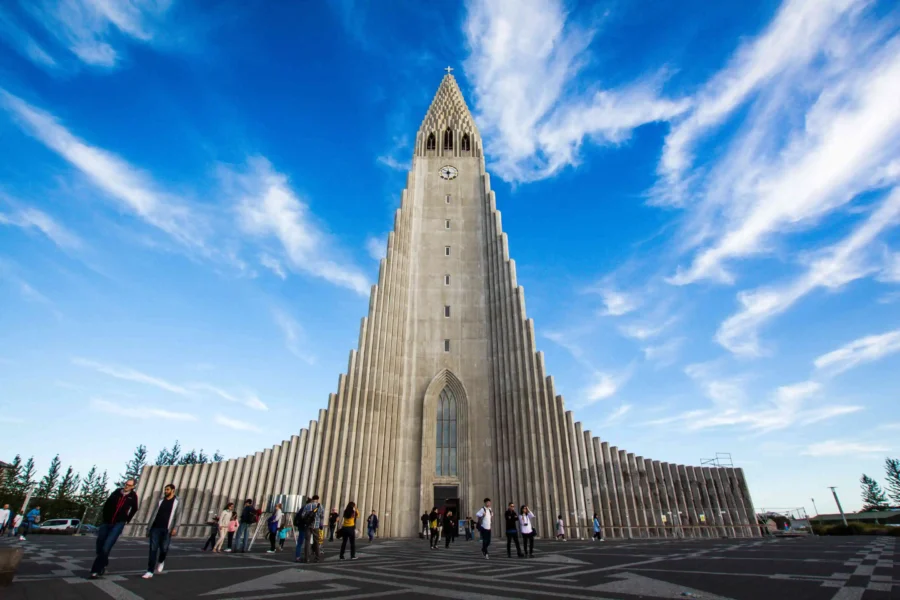
Once you’ve had your fill of geothermal wonders, make your way to Reykjavík. The city’s not like those sprawling European capitals—it’s compact, friendly, and, let’s be honest, a little offbeat.
Kick off with Hallgrímskirkja. This towering, almost alien-looking church (think basalt columns, but in concrete) gives you the best city views if you brave the elevator to the top. My first time up there, the wind nearly froze my face off, but the view was worth every shiver.
Wander down to Harpa Concert Hall. Even if there’s no concert, the glass facade catches the light in ways that’ll keep your camera busy. Don’t miss the Sun Voyager sculpture on the waterfront—it’s a bit kitschy, sure, but sometimes the sky behind it turns the whole scene into something magical.
If you’ve still got energy (I usually do, especially when snacks are involved), check out the Sky Lagoon. It’s a newer spot with an infinity pool right over the sea—great for sunset, and honestly, a little less touristy than the Blue Lagoon.
- Key stops:
- Hallgrímskirkja
- Harpa Concert Hall
- Sun Voyager
- Sky Lagoon (optional but worth it)
Day 2 & 3: The Golden Circle and South Coast Adventures

The Golden Circle is classic Iceland—a wild blend of history, geology, and scenery you’ll replay in your head for years. The South Coast puts you right up against some of the world’s most jaw-dropping waterfalls.
It’s two days of “wow” moments, and every stretch of road is worth it.
Thingvellir National Park and Geysir Area
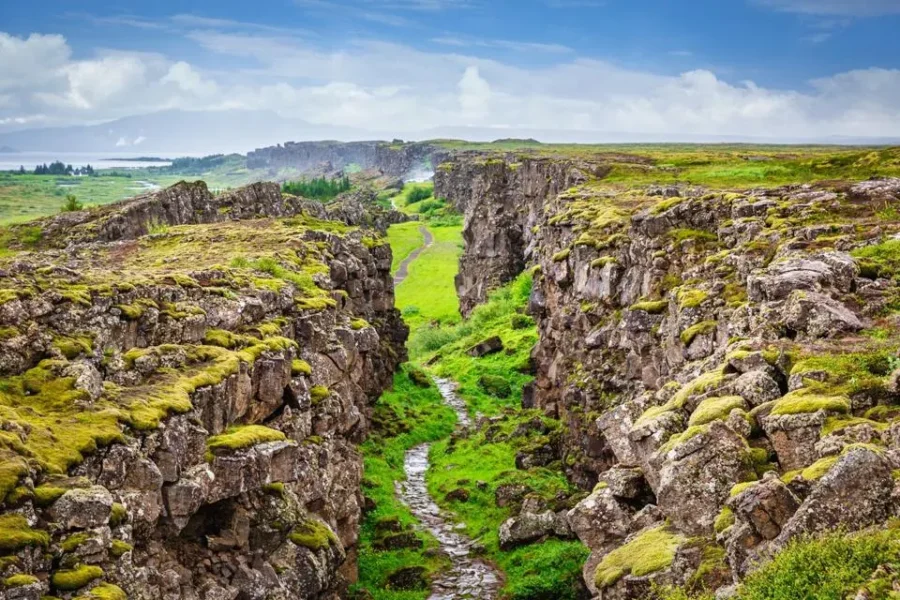
Thingvellir National Park feels like stepping into Iceland’s soul. Here, you can literally stand with one foot in Europe and one in North America, right in the rift valley.
This place hosted the world’s first parliament in 930 AD—hard to wrap your head around, isn’t it? The landscape is all jagged lava, glassy rivers, and moss that looks like it belongs in a fantasy novel.
Bring a rain jacket; the weather loves to keep you guessing. Next up, the Geysir geothermal area is about 45 minutes away.
The original Great Geysir rarely erupts these days, but Strokkur puts on a show every 5 to 10 minutes. I never skip this stop—the photos look unreal, and the anticipation is half the fun.
Gullfoss and Secret Lagoon Stops

Gullfoss always blows me away, no matter how many times I visit. The waterfall thunders in two drops into a deep canyon, and if the sun’s out, you’ll probably spot a rainbow hovering in the mist.
You can get surprisingly close to the falls—there’s a trail that takes you right to the edge. Waterproof shoes? Highly recommend.
After you’ve soaked up the roar, detour to the Secret Lagoon in Flúðir. It’s much more chill than the Blue Lagoon, and the setting—steamy, surrounded by green hills—just feels like real Iceland to me.
Selfoss and Seljalandsfoss Waterfalls

Keep cruising south and you’ll find Selfoss, a wide, foamy waterfall framed by black rock. It’s not the tallest, but it’s got this peaceful vibe and way fewer crowds.
Seljalandsfoss comes next, and honestly, it looks like it’s straight out of a fairy tale. You can walk behind the 60-meter fall—bring a poncho or just embrace the spray.
If you wander a bit further along the trail, you’ll stumble on Gljúfrabúi, a hidden waterfall tucked inside a mossy cave. The South Coast really doesn’t hold back when it comes to epic water features.
Day 4: Black Sand Beaches and Vík Region

Today’s all about coastal drama. Vík and the surroundings serve up black sand, towering cliffs, and scenery that feels almost extraterrestrial.
Reynisfjara Black Sand Beach
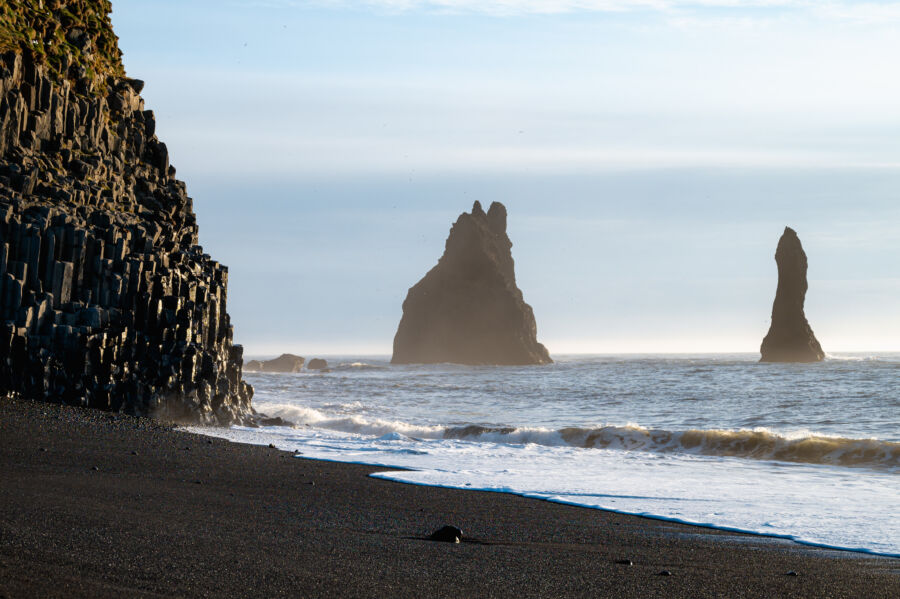
Anastasia / Adobe Stock Reynisfjara is no ordinary beach. The sand’s jet black and soft, and the Atlantic waves crash in with real attitude. The Reynisdrangar sea stacks rise just offshore—locals say they’re trolls caught by the sunrise.
Basalt columns line one end, perfect for those “look where I am” photos (I’ve taken too many, honestly). Stay back from the water, though—sneaker waves here are no joke.
Bring sunglasses, because the wind will whip that sand right into your eyes. There’s a small café by the parking lot, but if you want to linger, pack a thermos and just watch the light change on the stacks. Early mornings or late evenings are pure magic.
Dyrhólaey and Coastal Views

Drive west to Dyrhólaey, a massive arch-shaped promontory with views that stop you in your tracks. On one side, black beaches stretch forever; on the other, mossy fields and distant glacier caps.
If you’re here from May to August, keep your eyes peeled for puffins nesting on the cliffs—binoculars help. The gravel road to the upper parking lot is bumpy but doable.
There’s a white lighthouse up top, and the wind here? Relentless. I lost a beanie once, straight over the edge. Walk the short trails, watch the waves crash, and snap those wide-open landscape shots.
Sólheimasandur and Skógafoss

Sólheimasandur is all black sand and emptiness—except for the famous DC-3 plane wreck. It’s a 45-minute walk each way, exposed and a bit eerie, but the sight of that battered aircraft is unforgettable.
When you get back to your car, head to Skógafoss. This waterfall is iconic—water thunders down in a wide sheet, and you can walk right up to the spray. If the sun’s out, rainbows are almost guaranteed.
Climb the staircase to the right for a view from above. If you’re up for a side trip, check out Gljúfrabúi, a smaller waterfall hidden in a mossy crevice nearby. It’s slippery, damp, and totally worth it.
Day 5 & 6: Vatnajökull Glacier and Southeast Iceland

Now you’re heading into glacier country—think massive ice, wild rivers, and landscapes that feel one-of-a-kind. The scenery mixes mossy canyons, iceberg-filled lagoons, and, of course, unpredictable Icelandic weather.
Skaftafell and Glacier Hiking Routes

Skaftafell is a hiker’s dream, tucked at the edge of the vast Vatnajökull Glacier. Trails wind to hidden waterfalls, and if you’re lucky, you’ll spot puffins teasing you from the cliffs.
You can stick to easy strolls or join a glacier hike—local guides will strap you into crampons and lead you onto the blue ice. I felt like an Arctic explorer the first time I tried it.
The trails are well-marked, but don’t get overconfident—weather flips fast. One time, clouds parted just as I reached the overlook, revealing the whole glacier sparkling below.
Pack snacks, a good rain jacket, and those thick wool socks you always thought you’d never need.
Tip:
Bring a little cash—sometimes the snack stands at the visitor center don’t take cards.Svartifoss and Fjaðrárgljúfur Canyon

Svartifoss is that waterfall you’ve seen in a million photos, pouring over black basalt columns. The hike up takes about 45 minutes and climbs steadily, but the view at the top is worth every step.
Eat your lunch up there—it’s surprisingly peaceful, just you and the sound of water. If you want something wilder, drive east and visit Fjaðrárgljúfur Canyon.
This place is so green and mossy it almost looks fake. The rim trail gives you those classic “tiny human, giant landscape” shots.
Be careful—the paths get slick after rain. I once tried jogging along the edge (not my smartest move).
Jökulsárlón and Höfn

Jökulsárlón is a glacier lagoon filled with floating icebergs—giant chunks breaking off Vatnajökull. If you can, take a boat tour; weaving through blue-and-black ice is both freezing and unforgettable.
Just across the road, Diamond Beach sparkles with shattered ice on black sand. It’s a scene you won’t find anywhere else.
About an hour east, you’ll roll into Höfn, a laid-back fishing town. It’s not fancy, but you’ll find gas, groceries, and, if you’re smart, the best langoustine (Icelandic lobster) you’ll probably ever eat. Warm up with a meal and take in those glacier views—you’ve earned it.
Day 7 & 8: East Fjords and Scenic Villages
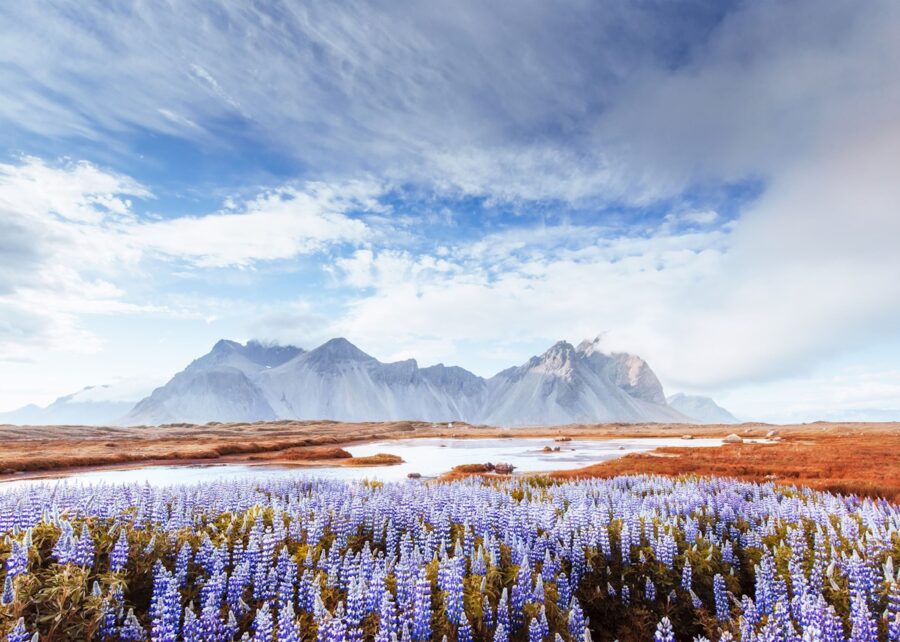
The East Fjords feel like a secret, even after all the hype. Steep green mountains on one side, shimmering sea on the other—you’ll find a rare calm here that’s missing from the rest of the ring road.
Slow mornings in colorful fishing villages, and if you’re lucky, a glimpse of reindeer or seabirds out in the wild. This is the Iceland that sneaks up on you and sticks in your memory.
Seyðisfjörður and Egilsstaðir
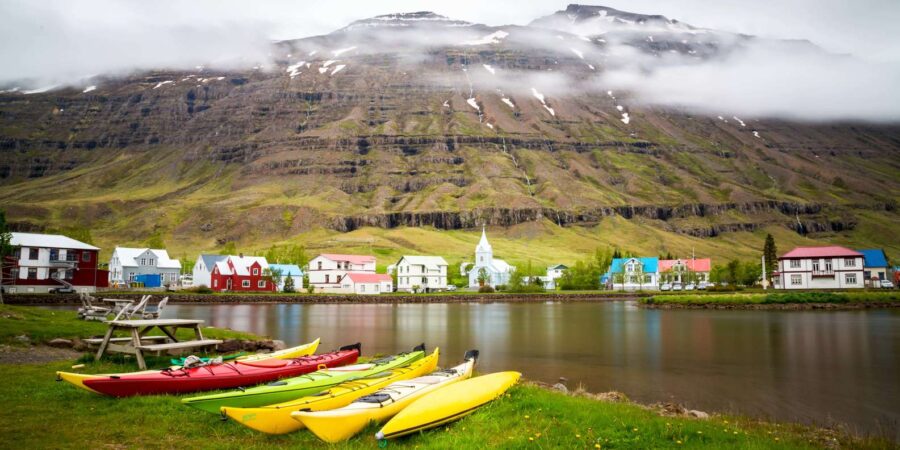
If you’re chasing that “tiny town at the edge of the world” vibe, Seyðisfjörður nails it. It sits in a narrow fjord, old wooden houses painted in every color—there’s even a rainbow road leading right to the blue church.
Art pops up everywhere, and the mountains practically press in on the harbor. You’ll feel nature wrapping you up from every side.
The drive over the mountain pass from Egilsstaðir can get twisty, especially if fog rolls in, so take your time. Egilsstaðir itself is surprisingly practical—a big grocery store, gas stations, and it’s basically the supply hub for East Iceland.
If you’re camping, both towns offer simple, well-kept campgrounds. Waking up to that crisp mountain air? It’s the kind of thing you’ll talk about for years.
Here’s a tip: the fish soup at Seyðisfjörður’s Ferry Terminal café is legendary. Try it if you can. Sometimes, if luck’s on your side, you’ll catch live music in the evening. It’s a cozy, unforgettable scene.
Wildlife Watching in East Iceland
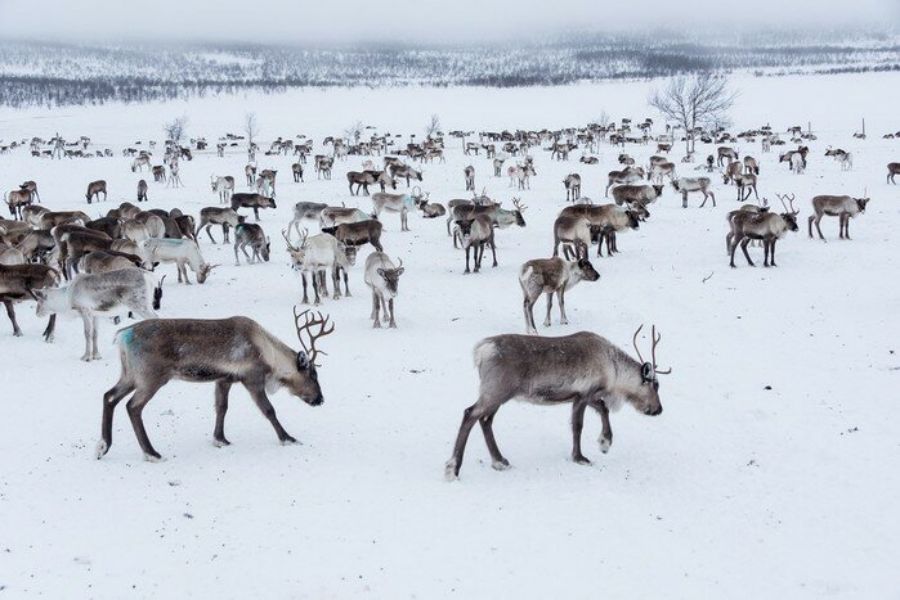
The East Fjords just might be the top spot in Iceland for wild reindeer. I’ve driven this stretch three times now, and every single trip, reindeer have shown up—just chilling by the road. Spring and early summer are prime time, so if you’re road-tripping in June, keep your eyes peeled.
Bird lovers, don’t leave your binoculars behind. This is puffin country, especially around Borgarfjörður Eystri. Pull over, walk quietly, and you might get close enough for a killer photo. The area’s also got sea eagles, seals flopped out on rocks, and every so often, an arctic fox makes a cameo.
Here’s a cheat sheet for animal spotting:
Animal Where to Look Best Time Wild Reindeer Grassy hills near Egilsstaðir and along Route 1 Spring-Summer Puffins Borgarfjörður Eystri Cliffs Late May to August Seals Rocky beaches, by fjord inlets All year Sheep wander the roads too—classic Iceland. Slow down, let them cross, and you’ll probably get a wave from a farmer who somehow knows every sheep by name. Wildlife here turns even a lazy drive into a highlight.
Day 9: Mystical North Iceland and Akureyri

North Iceland has a way of feeling like a different planet—wild coastlines, crazy colors, and landscapes that look like they belong in a sci-fi movie. Today packs in a lot, but it’s all the good kind of busy.
Dettifoss and Waterfall Wonders

Kick off the day by heading to Dettifoss. Standing next to this beast, you’ll feel tiny—Europe’s most powerful waterfall, and your rain jacket won’t save you from the spray. The gravel road in can get bumpy, but don’t let that stop you. The first blast of mist? Unreal.
Nearby, Selfoss and Hafragilsfoss wait for those with extra energy. If you’re pressed for time, stick with Dettifoss, but if you’re game, a mini waterfall circuit is totally worth it. Just watch your step—paths get slick when it rains. Sturdy boots are your friend here.
Mývatn and Geothermal Pools
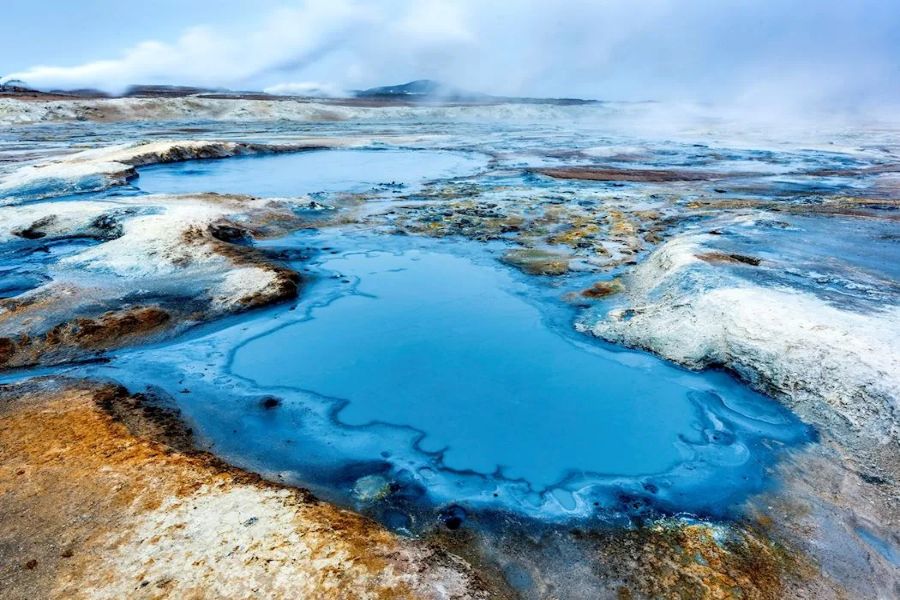
Next, make your way to Lake Mývatn. This place is weird in the best way—volcanic craters, bubbling mud pots, and steam hissing out of the ground. The sulfur smell is… well, it’s part of the package. Give it five minutes; you’ll barely notice.
Don’t miss the Mývatn Nature Baths. It’s like the Blue Lagoon’s chill cousin, minus the crowds and with way better views—lava fields and steam, not selfie sticks. Locals call it “Jarðböðin.” If you can, soak at sunset. That golden light on the volcanic rock? Chef’s kiss.
Walk over to the pseudo craters on the lake’s south side. They’re not true craters, but the shapes are wild—and totally worth a photo stop. Bring your own swimsuit and towel. Most pools don’t rent towels, and shivering after a soak is nobody’s idea of fun.
Whale Watching and Akureyri Sights

Roll into Akureyri to finish the day. It’s the “Capital of North Iceland,” but honestly, it feels more like a mountain village than a city. Before you settle in, consider a whale watching tour from Húsavík or Dalvík. I’ve seen humpbacks breach here—one of those moments you’ll replay in your head for years.
Akureyri’s got colorful houses, a tidy harbor, and that church on the hill that somehow looks perfect from every angle. The botanical gardens are a hidden gem—Arctic plants from all over, and barely a crowd. If you stroll the waterfront, keep an eye out for seals bobbing by the docks.
Wrap up with dinner at a cozy café. Order the fish stew (“plokkfiskur”) if it’s on the menu—creamy, comforting, and just right for a chilly night.
Day 10: West Iceland and Snæfellsnes Peninsula

You’re on the home stretch now, and honestly, some of Iceland’s best corners are waiting out west. This isn’t just about landmarks—it’s about those wild landscapes, tiny towns, and the kind of sea air that wakes you up better than coffee.
Kirkjufell and Kirkjufellsfoss
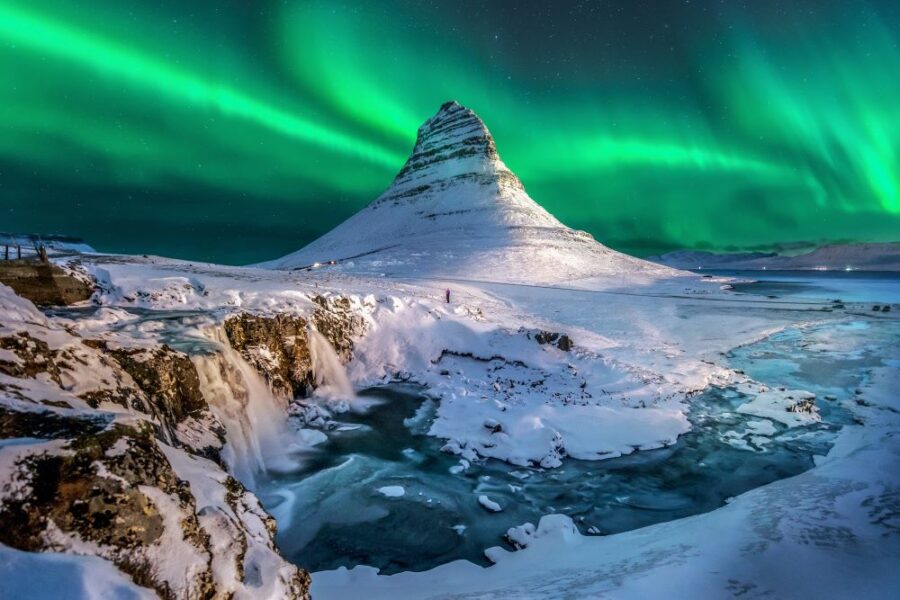
Kirkjufell—yep, that pointy green mountain from a thousand Instagram shots—is even more impressive in real life. The wind comes off the fjord and makes you zip your jacket up, but the view? Unreal. If you catch it early, mist hugs the slopes, and at Kirkjufellsfoss, the little waterfall out front, it’s pure magic for photos.
It’s a quick, easy walk to the base of the falls. Sometimes, you might get the place to yourself for a few golden minutes. The trail can get slick, so watch your footing, especially after rain. Summer brings green hills, but I’ve loved it in early autumn—the colors pop, and there are fewer people elbowing for the perfect shot. Wildflowers, seabirds, maybe even an Arctic fox if you’re lucky. Take your time—this is a spot to just breathe it all in.
Stykkishólmur and Djúpalónssandur
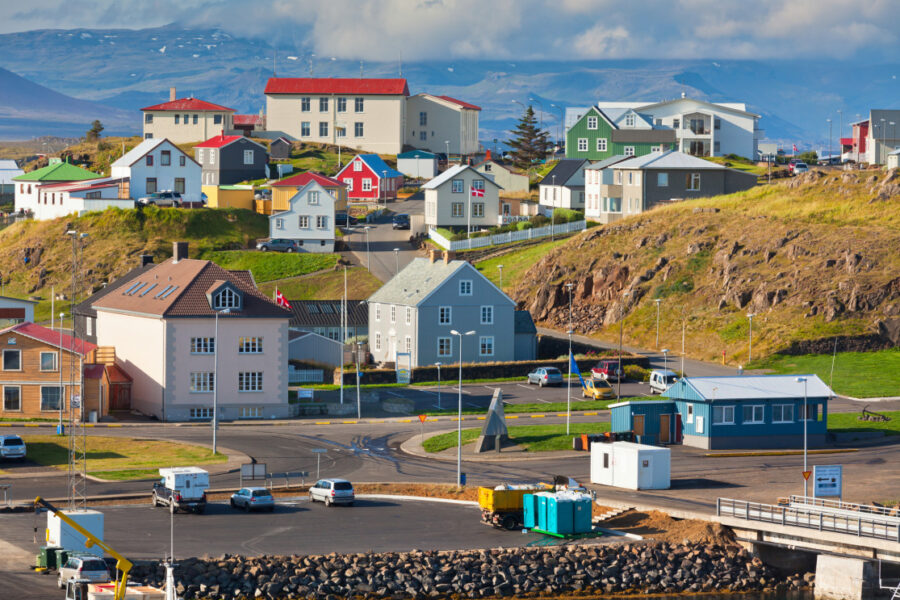
After Kirkjufell, you’ll find Stykkishólmur—a harbor town that’s low-key but full of Icelandic charm. Colorful houses, a snug little harbor, and honestly, the café by the water has cinnamon buns that could compete with Reykjavík’s best. If quirky museums are your thing, check out the Volcano Museum. On a sunny day, climb up Súgandisey Island for views over Breiðafjörður Bay.
Next, drive out to Djúpalónssandur on the peninsula’s southern edge. The black pebble beach here feels rugged and a bit mysterious—rarely crowded, always dramatic. Rusty shipwreck bits lie tangled among the stones, and you’ll spot those odd “lifting stones” fishermen once used to test their strength. Try your luck! The walk down is steep and uneven, so take it slow. Sometimes you’ll see seals offshore, and on clear days, Snæfellsjökull glacier looms in the distance, looking as wild as ever. This place always feels like the world’s edge—raw and windswept.
Adventure Activities Along the Ring Road
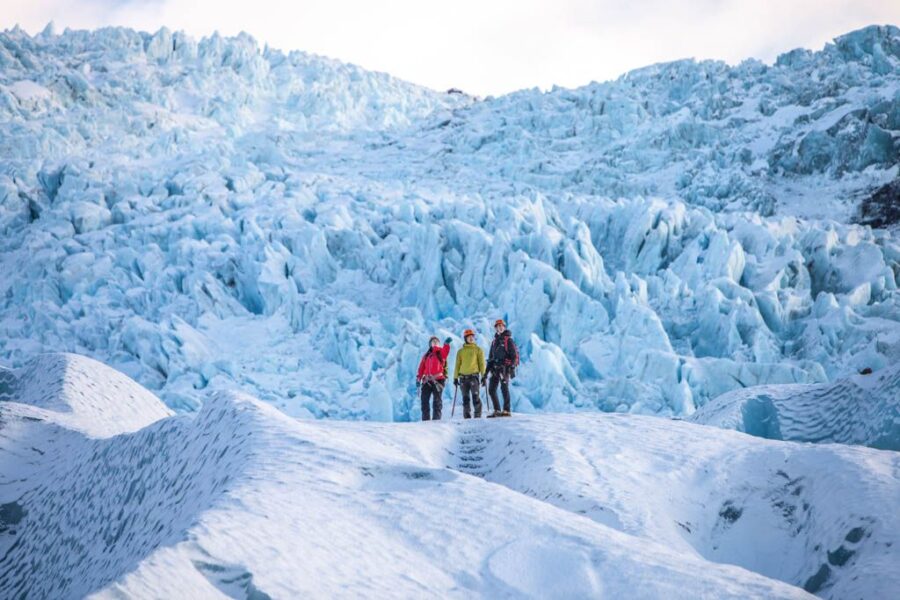
If you want to do more than just stare out the window, Iceland’s Ring Road is packed with ways to get your hands (and boots) dirty. Glacier hikes, ice caves, and some of Europe’s best hiking trails—there’s no shortage of real adventure.
Glacier Tours and Ice Cave Expeditions
Don’t just admire those glaciers from afar—get up on them. Around the south coast, especially near Vatnajökull and Skaftafell, guides will get you geared up to hike across the blue-white ice. It’s wild, a little intimidating, and absolutely worth it. In winter, you can crawl inside glowing blue ice caves carved by meltwater. Even in summer, smaller caves sometimes open up with a guide. The gear can be awkward, but the crunch of fresh glacier ice under your boots? Nothing else like it.
If you’re curious what’s running during your trip, check out current guided tours. Most tours leave from places like Höfn or Vik, so you won’t have to go far off-route. There are family-friendly options, too.
Top Hiking Trails
Hiking in Iceland never gets old. For a quick fix, climb the stairs next to Skógafoss waterfall. Your legs will complain, but the view is unbeatable. Get there early if you can; the crowds show up fast in summer.
If you’re here in July or August, the Highlands open up and the Laugavegur Trail becomes an option. It’s famous for a reason—multi-day, but even a short hike from Landmannalaugar into the colored hills is a stunner. Don’t skip the steamy hot springs at Landmannalaugar for a post-hike soak.
When the weather’s kind, trails in the East Fjords or around Lake Mývatn reveal wildflowers, lava fields, and a kind of silence you don’t find many places. I always find the east to be emptier, quieter—if you’re craving solitude, head that way. Always check weather and trail updates; Iceland’s mood can shift fast, and what starts sunny can turn wild by lunch.
Practical Travel Information and Insider Tips
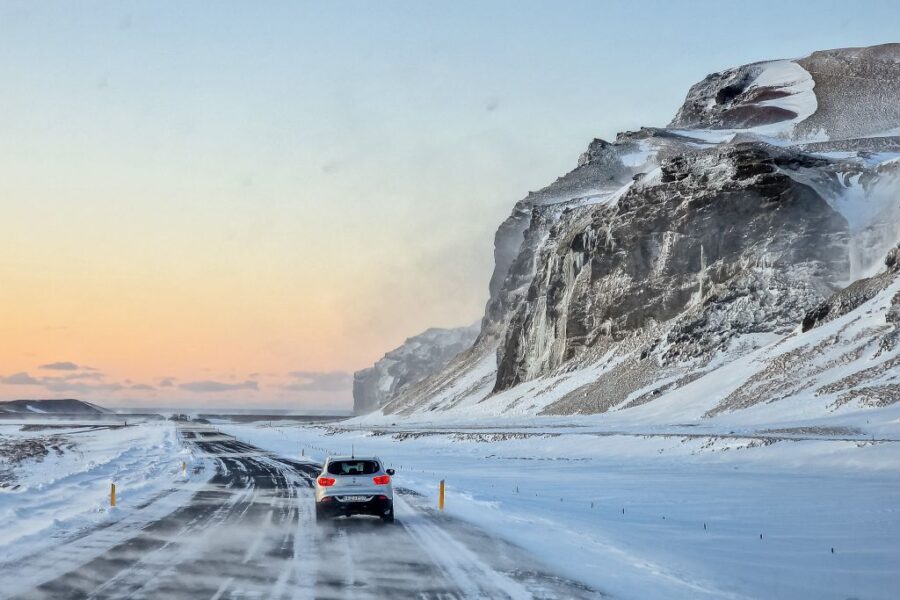
Driving the Ring Road is a blast, but a great trip comes down to being prepared and paying attention to the little things. Weather, safety, and knowing how to find the secret hot springs all make a difference.
Staying Safe While Driving
Iceland will test your driving skills—fast-changing weather, sneaky one-lane bridges, blind curves, sheep on the road, and wind that’ll rock your car. Don’t expect endless straight highways.
Check local road conditions at least twice a day, especially in winter. Renting the right car matters—a 4WD is a good call most months, just for peace of mind. Locals will always say: slow down on gravel and obey the speed limits. If you’re not sure where to stop or stay, you can find places to stay along the route.
Keep a reflective vest and warm clothes in your car, just in case you get stuck waiting out a storm. And pack snacks—some stretches go for hours with nothing but landscape.
Northern Lights Spotting Guide
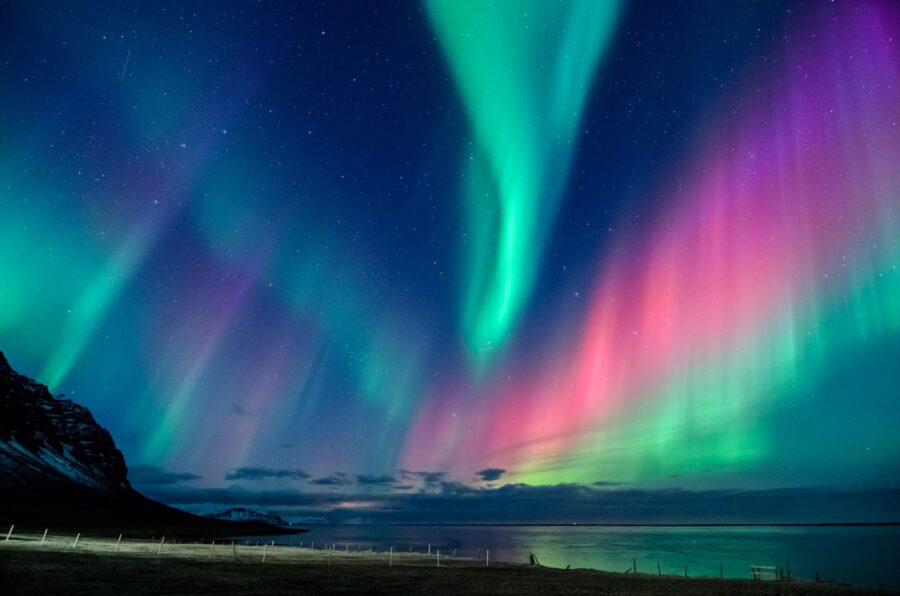
Catching the northern lights in Iceland? Honestly, it feels like magic—when it works out. Your best shot runs from September to April, when the nights are long and the darkness is on your side.
Here’s the real trick: leave the city glow behind. Skip the crowds and head for tiny villages, remote guesthouses, or just about anywhere rural and quiet.
Don’t wear yourself out chasing the lights every single night. Sometimes, clouds just refuse to budge, and that’s how it goes. Always peek at the aurora forecast after dinner, and if the sky’s clear, bundle up and get outside by 10 PM.
If you’re after photos, bring a tripod and set your camera for long exposures. I once lay on my rental car’s hood for hours, just watching green ribbons twist overhead, not another soul in sight. Sometimes you strike gold, sometimes you don’t, but honestly, that’s half the fun.
If you’d rather not go it alone, there are plenty of guided experiences—northern lights tours and activities pop up all over the country.
Unique Hot Springs Off the Beaten Path
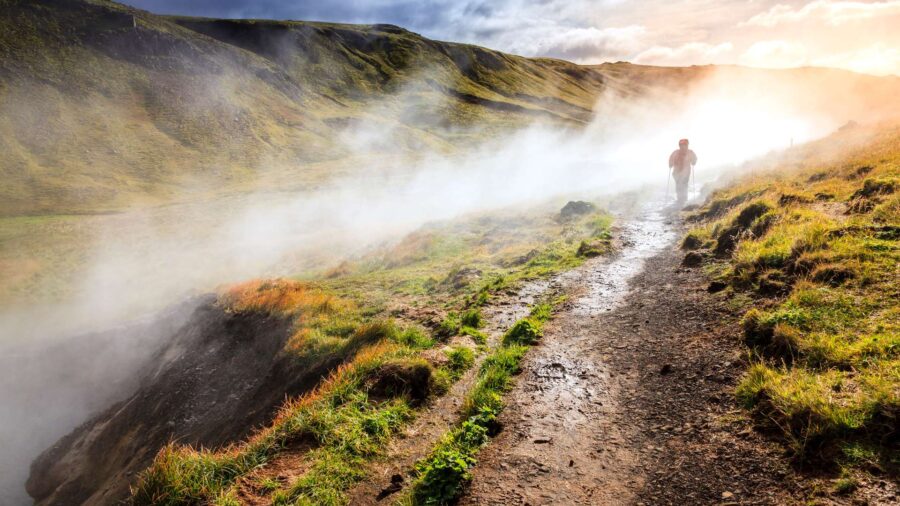
Sure, the Blue Lagoon is iconic, but the real treasures? They’re tucked away from the tour buses. Reykjadalur, for instance, is a warm river you’ll reach after an hour’s hike from Hveragerði.
It’s something else, soaking in a steaming river while sheep wander by and the valley glows in color. The trail can get muddy after rain, so bring a towel and dry clothes for the hike back.
There’s a whole world of lesser-known hot springs, especially up north and out east. Grettislaug, right by the sea, feels almost private—sometimes just a handful of people, steam swirling in the cold air. Always clean up after yourself, keep the noise down, and never leave trash. A little respect goes a long way.
Use a map or chat with locals to sniff out these secret pools. Some have small entry fees or rules, so double-check before you go. Every once in a while, you’ll find yourself alone, snow all around and hot water bubbling up. That’s the kind of Iceland memory most visitors miss.
Frequently Asked Questions
Driving Iceland’s Ring Road in 10 days? You’ll see scenery that’s almost unreal, run into more sheep than cars, and probably lose count of the waterfalls. Planning ahead helps, especially if you want to squeeze in both the big names and some quieter places.
What are the must-see attractions along the Iceland Ring Road in a 10-day itinerary?
Don’t skip the Golden Circle. Yeah, it’s popular, but there’s a reason—Gullfoss Waterfall, Thingvellir National Park, and Geysir really are special.
Head south for Jokulsarlon Glacier Lagoon and Reynisfjara’s black sand beach—both are showstoppers. Up north, Akureyri and the Myvatn region offer quieter, but no less stunning, sights. If you can swing a detour to Kirkjufell mountain, do it—it’s worth the drive.
How should I budget my time between North and South Iceland during a 10-day Ring Road trip?
Most travelers, myself included, end up lingering in the south. The sights are closer together and, honestly, there’s just more of that “classic Iceland” vibe. I’d go four or five days in the south and southeast, then three or four up north, and save a day or two for the wild eastern fjords and Snaefellsnes Peninsula.
If you’re into hot springs and geothermal fields, slow down around Myvatn. But if you’re chasing icebergs and seals, hang out in the southeast a bit longer.
Don’t blink or you’ll miss Hvitserkur—the troll-like rock formation in the northwest. The East Fjords are full of empty hiking trails, tiny fishing towns, and even wild reindeer (if you’re lucky).
I love Seydisfjordur for its creative, artsy energy—plus, the coffee is surprisingly good. For a soak without the crowds, scout out smaller pools like Seljavallalaug or Grettislaug. They’re absolute gems
What are the driving conditions like along the Ring Road in Iceland during different seasons?
Summer’s a breeze. You get endless daylight, clear roads (unless a sheep feels rebellious), and you can drive late into the night if you want to chase the midnight sun.
Spring and fall can surprise you with snow or ice, especially up north or on higher ground. Winter? It’s a different beast—wind, snow, and abrupt road closures aren’t rare. If winter driving makes you nervous, stick to summer or early fall.
Can you recommend accommodations or camping options for a 10-day self-drive tour of the Ring Road?
Most folks mix guesthouses, farm stays, and the occasional hotel. Summer fills up fast, so book early if you want the good spots. Hostels work for last-minute plans but don’t count on empty beds.
Some of my favorite nights have been in family-run farmhouses, waking up to homemade bread and sheep outside the window.
If you’re camping, you’ll love the freedom. Campgrounds dot the Ring Road, but wild camping isn’t really allowed anymore. Don’t expect much in the way of luxury—a hot shower at a campsite sometimes feels like winning the lottery.
What are essential tips for driving safely on Iceland’s Ring Road over a 10-day period?
Keep both hands on the wheel—trust me, Icelandic wind might shove your car sideways when you least expect it.
Gravel patches sneak up on you, and those single-lane bridges? They demand your full attention. Watch out for sheep too; they wander right onto the road without a care.
When you rent a car, make sure it comes with solid insurance. I really can’t stress that enough, especially with the wild weather and unpredictable conditions.
Before you head out each day, check road.is for real-time road conditions. Don’t skip this step, even if the skies look clear.Fuel up whenever you see a gas station, especially in the east. Out there, stations can be few and far between, and you don’t want to end up stranded.
And please, don’t stop in the middle of the road for photos, no matter how jaw-dropping the view is. Pull off safely—your Instagram can wait, but your safety can’t.Book Your Dream Experience
More Travel Guides
